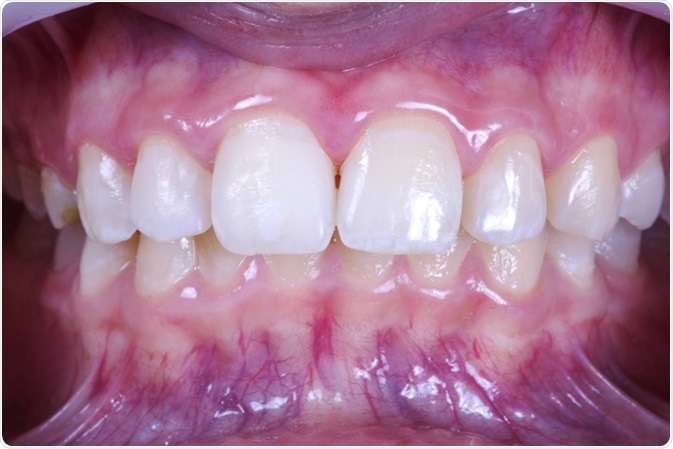Tooth remineralization is a reparative process, which occurs naturally and daily inside the mouth. This process repairs the lost enamel (outermost part of the tooth) and helps in preventing cavities.
Tooth Remineralization –A Process Reversing Tooth Damage
The oral cavity is inhabited by both beneficial and detrimental micro-organisms. Some microorganisms metabolize sugar in the mouth and release acid, which can then damage tooth structure through loss of calcium and phosphate ions from the enamel surface. This process is known as demineralization and is the primary cause of tooth cavities. Saliva, fluoride, dietary factors, and probiotic bacteria are involved in prevention of demineralization

Local tooth enamel hypoplasia. Surface after remineralization. Image Credit: Eduard Tanga / Shutterstock
Role of Saliva
Saliva neutralizes harmful acids and supplies the teeth with calcium and phosphate ions for remineralization. A continuous circulation of the saliva prevents the accumulation of the debris and washes away acid-producing bacteria. Bacterial removal allows the calcium absorption on the tooth surface. Hence, a rich supply of saliva is vital in promoting the remineralization process.
When the rate of bacterial production exceeds the rate at which saliva removes harmful bacteria, demineralization will occur. In case of dehydration, the salivary production slows down as the mouth becomes dry and salivary glands become less active. Hence, dehydration slows down the remineralization process.
Role of fluoride
Fluoride plays a crucial role in preventing demineralization and supporting remineralization of teeth. When applied to the teeth, fluoride replaces some of the calcium in hydroxyapatite present in the enamel. This change both assists in remineralization with phosphate from saliva and makes hydroxyapatite more resistant to damage from acids in the mouth.
Fluoride is generally applied to the teeth in the form of toothpaste or varnish. There are also some commercially available products that dentists can use for patients who require a professional level of intervention to reverse severe demineralization.
Key Steps to Increase Remineralization Process
Demineralization and remineralization are naturally occurring processes. However, a healthy oral environment promotes remineralization over demineralization.
- Brushing teeth twice daily and flossing can decrease bacterial growth and therefore decrease the presence of damaging acids
- High consumption of sugars, sugary foods and drinks should be avoided, as the presence of sugar increases the production of acids by bacteria
- Consumption of foods rich in vitamins and minerals such as green leafy vegetables, cheese, fish, and eggs promote remineralization
- A regular dental check-up helps to identify and treat demineralization early. An early detection and treatment of demineralization helps patients minimize dental complications due to caries (cavities).
- Demineralization can be treated by fluoride varnish application to tooth surfaces to promote remineralization.
Further Reading
Last Updated: Nov 11, 2018